Before I begin, it’s disclaimer time. My intention in this post is not to say ehehehe I’m so clever I know much more than these pictures these silly uneducated fools blahbalbhablabh, rather, I want to make it clear that you should not trust infographics. Not one bit. Or at least, verify what they say – if that means looking at whatever sources the graphics cite, or simply doing your own research, verify the damn things. Getting more than one opinion is always good. If something intrigues you, go elsewhere, see if they say the same thing. Get more in-depth information, rather than just singular facts and figures.
On the subject of sourcing, I bet you could find a phenomenal amount of words or opinions on my blog that are not sourced – but I do not pretend to be the be-all and end-all of knowledge. On my page, I share what I know and what I think I know. My intention is never to suggest that I have a perfect grasp on, well, anything. I just write about what I enjoy writing about.
And yes, I’m aware some infographics are well-researched and well cited. Yes, some are very good. Yes, some are worthwhile, but on the most part, infographics do one of two things:
- Are straight-up misleading, with no source or anything, saying things that are vaguely connected to truth.
- Don’t really give you enough information, or show a complex matter in a very black and white manner.
Having seen some very dodgy infographics on the internet, I thought I would take the time to do some nitpicking and maybe help you to be wary or even spot some real dodgy infographics. Or even better, to encourage you not to look at infographics, and instead do your own research.
One of the more well-known historical infographics is this video:
And it is good. It shows raw data in a compelling manner. There is no reason to believe these are wrong in any way.
Here are the total casualties (roughly) in a pie chart which I found online. Again, no real reason to think its wrong.

So whats the problem here? Well, it’s the fact that someone could take a look at these graphs (and as many do) and simply say. Oh wow, the Soviets suffered the most casualties. Therefore they did the most to win the war. This line of thinking then evolves a bit. It can even become The Soviet Union was capable of single-handedly defeating Germany. The Soviets carried all others to victory.
See how these things can get out of hand? All because there is not enough information. One can easily come to these conclusions, looking at a few infographics. Research to the extent of simply reading a book or two will make you understand more deeply what happened and why. (in this case, that the Soviets and the Western Allies needed each other equally).
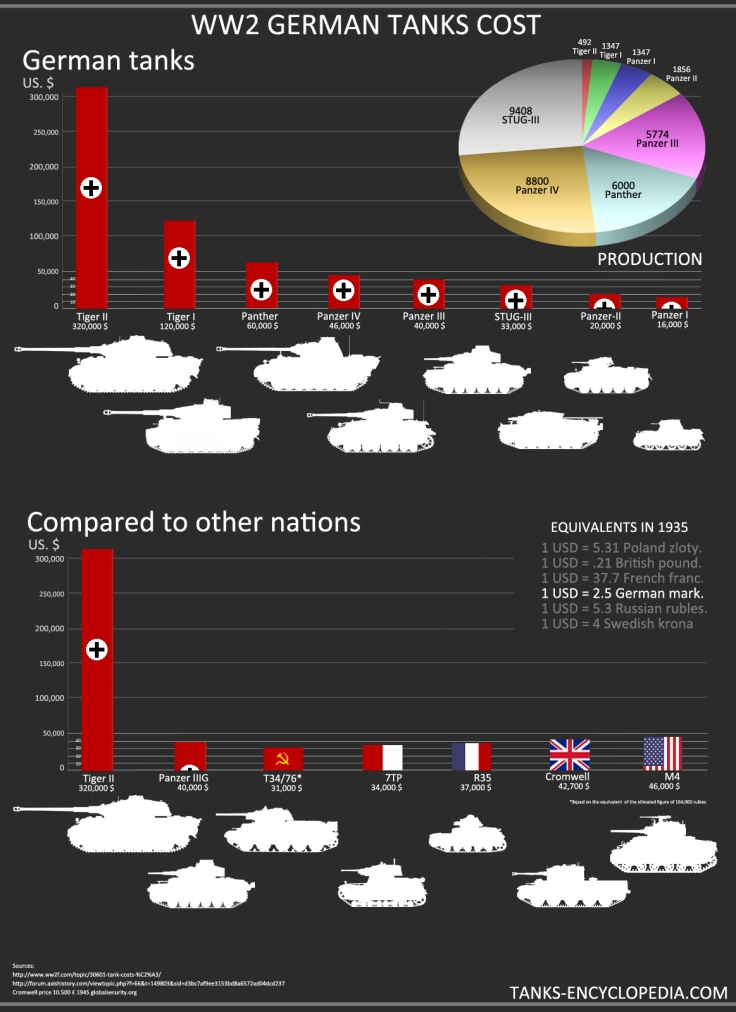
This well-sourced graphic, for example, dictates well (tanks-encylopedia I have found is a trustworthy site) the costs of each of these vehicles. But there is still a lot missing. Do these costs include ammunition or support weaponry for each vehicle? If so, do all the vehicles include this, or do some not? Are these costs for the entire production runs of each tank? Why does the graphic rather unfairly show the Tiger II – one of Germany’s most expensive tanks – against some of the most inexpensive of its enemies? granted it does show the Panzer III, one of its most inexpensive, but still. Heavy tanks of other nations are suspiciously absent.
If we were to compare roughly equal tanks, we would see a different side to the story (the numbers are very hard to find online but this video has an individual pouring over some monetary cost statistics for other tanks – this is much better because you have the benefit of what seems to be a knowledgeable person talking about it as well). It seems the IS-2 costed around $45,000 USD per unit, (as of the 1940 value of the currency), while a Tiger II costed over $140,000. Tiger I, $100,000. M26 Pershing, $80,000.
In this instance, the first infographic tells us that Germany probably spent way too much on certain tanks. But with more information, we can also see that in all likelihood Germany was completely outmatched economically by its enemies as well – other countries could afford to have far more tanks that were more or less the same price. The Soviets built around 4,000 IS-2s over the course of the war – while Germany managed only around 500 Tiger IIs, and 1,300 Tiger Is.

Anyway, you get the idea on that one. The above graphics are examples of showing concrete statistics only, which are then used in order to give a very much black and white answer to a very complicated question – ie one that cannot really be tackled in a black-and-white fashion. Strictly speaking, they are correct. There’s nothing factually wrong about them – it’s just that there isn’t really enough there for someone to formulate a significant opinion. Infographics are supposed to supplement your learning and research. They visualise certain elements of your understanding. Not substitute it.
Funnily enough, I covered my second point before the first. Lets move to the first, now.
What kind of infographics are misleading? Well, they are ones built off assumptions, such as the example I mentioned above. Ones that misinterpret or straight up misrepresent facts. Here’s a nice pro-Soviet graphic I found. You can always tell who the apologists are when they have not a single bad thing to say about the totalitarian regimes they have idealistic views towards.
(There is something I would also like to mention. According to some people on the internet, railing against Soviet atrocities in fact makes you a Nazi apologist – just because you happen to be attacking an enemy of Germany. This is silly, of course, but some people do seem to believe it. I hold a great disdain for totalitarian regimes of both Communist and Fascist natures. However, that is not to say that every single individual who lived in Nazi Germany supported the regime and was a raging evil monster – and likewise for the Soviet Union. Its up to you and me to use common sense and research in order to disseminate the two. There’s a reason that force was used to suppress opposing views in both states during the time – because many disagreed with it. .)
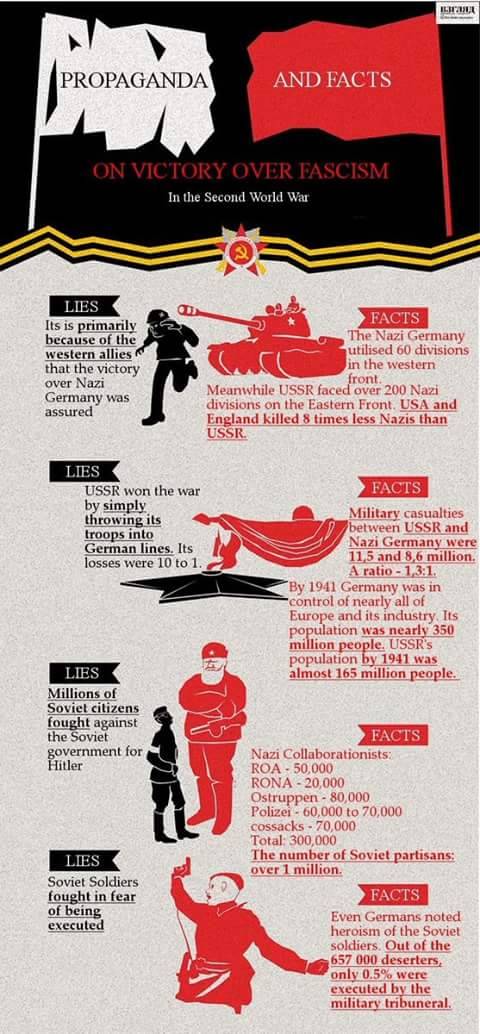
This graphic comes in two parts. It varies in truth – but the suggestion, however, that because the Soviets killed far more Germans means they alone won the war, is completely wrong. American lend-lease enabled the USSR to recover from its disastrous losses of 1941- at one point American Studebaker trucks were pretty much the only thing keeping the Russian supply chain going. Khrushchev believed that without lend-lease, Russia would not have won the war. The Luftwaffe was practically absent from the eastern front by the middle of the war, and had ceased to be by late 1944 – mainly due to the efforts of the Allies. The worlds oceans were almost an exclusively Allied domain come the middle of the war. Yet, the unmistakable might of the USSR’s ground armies were also instrumental to Germany’s defeat. There is a balance which this infographic has seemingly failed to grasp. The Allies and Soviets had to work together to win. Both sides helped each other more or less equally – it was an uneasy alliance, very much an “enemy of my enemy is my friend” type situation.
The next point starts well by trying to debunk a time-old misconception about the Soviet land doctrine. It is a common thought that throughout the war the Soviets simply used human wave tactics to pummel Germany into submission. This is false.
However, just when the graphic was on the up, it starts to go wrong again. It tries to equate the total population of all the territories occupied by the Third Reich with the Soviet Union ( is this a subtle acceptance on their part of the Soviet Union’s empire-like occupation of states like Ukraine and the Baltics, among others, by suggesting that Germany’s forceful annexation of various countries is just the same?)
While mathematically, there probably were more people living in the areas controlled by the Axis, than were controlled by the Soviets. The funny thing is that far more people probably would have sided with the Germans, had their verging-on insane racial attitudes and horrific war crimes towards local populaces did not ruin any chances of that. 350 million people may have lived in the areas occupied by the Third Reich at the height of its territorial gains, but things like the Einsatzgruppen terrorising anything east of Prussia almost guaranteed no support for the cause of anti-bolshevism whatsoever. It’s incredible to think that the Nazis utterly failed to tap in to this anti-communist sentiment. I suppose we can all be thankful for it.
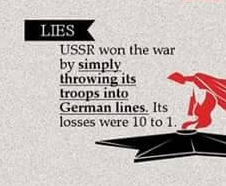
The Germans may have had 350 million people under their thumb, but the number willing to fight would be far fewer. Fewer still when you consider Germany’s strict racial policies (which were gradually relaxed as they lost more and more men) even if you take into account the forced labourers and people Germany conscripted into their army at gunpoint – those men gave up and surrendered at the first opportunity. I have read accounts of those conscriptees just shooting their officer, and then immediately surrendering to Allied forces.
Interestingly, the next point straight-up disproves the previous. 350 million in the sphere of Germany? Well, only 300,000 foreign people fought for Germany against Russia. While the Hilfswilliger (Hiwis) are suspiciously absent from the graphic, even with them the numbers are pitifully small – less than 0.1% of this “350 million” number. Whereas if we look at the amount of soldiers Russia had, those who were born and bred Soviets, who were incensed into fury against the fascists who had defiled their motherland during the early years of the war – this number was far greater than Germany.
Both sides had high levels of indoctrination of course – that is a discussion for another day. What I’m saying is that, the vast majority of the peoples of the USSR had a desire for revenge for the horrific manner in which the Third Reich conducted its war effort in the early years of the war. Compare this with a weakened Wehrmacht, supplemented by ‘osttruppen’ who had no desire to fight whatsoever, and the differences start to emerge.
But that does not mean that ‘human wave tactics’ were in fact a thing. Not for the whole war, at least. Quite the contrary. Instead of saying that ‘err Germany had loads of men too’ what they should have said was that by as early as 1943, the Soviets were employing tactics as complicated as the Germans. Deep Battle was a very Soviet version of the Blitzkrieg – which basically involved not one penetration of the enemy’s line, but multiple. Maskirovka was the systematic deception of the enemy on a massive scale – for example, deploying a division once in plain view during the day, then moving it back under the cover of night and “deploying it” again the next day – this gives the impression that there are more divisions in one area than there actually are.
These tactics were shown in maximum force during Operation Bagration. Paul Adair’s book on the subject is a great read if you are interested (albeit hard to find these days). He also discusses Deep Battle in great detail.
There is a famous quote from Zhukov which is often misunderstood. It goes like this:
“If we come to a minefield, our infantry attacks exactly as it were not there”
Many seem to believe that, in true spirit of the human wave strategy, the Russians would simply charge over the minefield without a care for the massive casualties they would inevitably take. This is very wrong – the quote actually means the opposite. Zhukov is referring to the very lengthy and difficult process of either disarming the minefield or going around it. Nearly always, these two options will actually result in you taking more casualties than if you just go straight through it and hope for the best.
The final “lie” of the infographic mentions the partisans – indeed, there was a general lack of a German equivalent. Even when the USSR was rampaging through the German heartland a few Soviet commanders did ponder why the Germans did not rise up like so many Soviet citizens did (Beevor tells of this in Berlin: Downfall 1945 – a good read on the closing days of the war). Many theorised it was because of the German tendency for discipline, and respect for authority. They simply could not bring themselves to rebel.
The final point is delightfully vague.
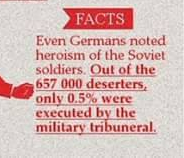
Indeed, Soviet soldiers displayed incredible courage, especially when fighting for a regime that cared little for them. Towards the end of the war, many Soviet commanders feared for the lack of discipline in their troops. There was an extreme lack, especially when it came to what can only be described as the Soviet rampage across Germany in 1945. However of course, not all Soviet soldiers were involved in this. This lack of order therefore means not much official action – no official action on things like, say, deserters, means no record. No record means, well, you get the idea – lots of impromptu ‘action’.
What I am saying is that I doubt that figure. I doubt it extremely much. If we think about the totalitarian aspects of the Soviet Union for a few moments, my reasons for this become clearer. Towards the end of the war, the Soviet high command feared the effect on the soldiers of their army, having seen the comparative luxury of Germany in comparison to the poor conditions of the average Soviet. Conditions in Germany and other western countries was of course far higher than that of Soviet Union. Their response to this concern? Hm, shall we improve our living conditions? No. They asked themselves have our soldiers developed…’anti-bolshevik’ ideas? Then they doubled down on propaganda. Even German citizens who were sympathetic to the Communist cause were treated just like the others. Why did you not join the partisans, the Russian soldiers would ask them. The fate in store for the ‘Hiwis‘, Red Army soldiers who collaborated with the Germans, if they were found by the Red Army was nine times out of then instant death – I’ll go over that more in a bit.
Prisoners of war and those who tried to surrender in general were also treated horrendously by the Soviet Union. Stalin’s own son got captured – the dictator disowned his son after the fact (whether he wanted to do this, for was forced to for the sake of image is another question entirely). Men who were released from German captivity at the end of the war were in some cases thrown into gulags – not only had they failed their country by not dying for it, they had been abroad for a long period of time. This meant only thing – they were a potential enemy and had to be liquidated. Even the wounded were looked down upon. You either win, or die.
I find the fact that “0.5%” deserters were executed extremely unbelievable because of the fact that Hiwis, the German-captured Russian soldiers, fought to the absolute last. Why? Because they feared Soviet reprisals if they were captured. Many fought to save their families – for such was the terror of the USSR, that if you betrayed it, your family would suffer just as you did. Therefore not many will have lived to be captured and then executed.
So yeah, what I’m saying is that if the ‘official’ statistic was 0.5% then it will not mean much due to the general chaos of the last days of the war. I imagine many deserters could likely have been shot out of hand – no record, no nothing. I would love to see where this infographic got those figures from. Mysteriously, there are no sources. I wonder what that could mean…?
Oh, but there’s more. More to this verging-on dangerously wrong infographic. Luckily, the next page (as far as I can see) is not as bad as the first. It still has problems, though. Once again, let’s go through it bit by bit.
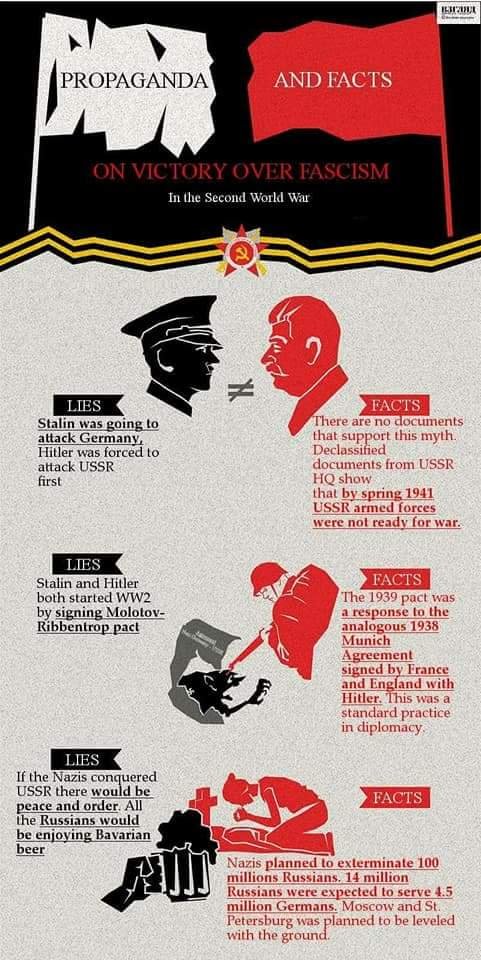
The first lie is about Hitler’s motive for launching Barbarossa. Yes, it was a lie that Hitler was forced to attack the USSR. The invasion came as a complete surprise to Stalin – even though there were some very suspicious signs in the days leading up to the invasion (such as Hitler deploying a large force on Stalin’s border, and the German diplomats suddenly leaving Moscow, Kriegsmarine ships setting up for a “diplomatic mission” near Konigsberg – this is mentioned in Beevor’s overview of WW2, The Second World War).
Diplomatic relations were considered to have been good between the two countries. There were even considerations for a formal alliance. Imagine how terrifying that would have been – if Russia had joined the Axis. Perhaps I should write a post about that possibility?
So yeah, Hitler was in no way forced to attack the USSR. He did so because he thought the Allies were subdued in the West (which they kind of were) and that he could secure a quick victory in the East. Although to be honest, I have only really seen people who are borderline Nazi apologists try to make this claim, that Hitler was “forced” to attack – it is a similar line of thinking to statements like “The invasion of Poland was justified” or “the Allies wanted war in 1939”.
The fact – that the USSR was not prepared for war – is true. The USSR was not ready at all for a full-scale German invasion and it was not prepared for the relentless attack that would befall them in June 22 of 1941. Stalin had no desire for war – part of the reason he signed a non-aggression pact with Germany in the first place. He was incredibly shaken at the start – and there would always be a niggling doubt in the back of his mind about his disastrous handling of Barbarossa. Had he not had absolute power as dictator, he likely would have been removed.
But what was one of the reasons the USSR was so woefully underprepared? Oh yes, Stalin had ruthlessly purged his army of millions of personnel, including talented officers. Crippled by these losses and paralysed by fear, the Red Army of 1941-1942 was incredibly weak. I don’t think this infographic would like to mention that part of the story, though.
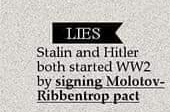
Of course, you view things in a literal manner, the start of the war was Hitler’s invasion of Poland. This triggered Britain’s guarantee and thus entered them into the war along with France and their empires. However, if you look beyond the infographic you can look at things contributing to the eventualy ignition of the powder keg going back before the end of the 19th century. even the official start date of the war is something that is debated. The Italo-Ethiopian war of the mid 30s is one such date, the Spanish Civil war another, and the Japanese invasion of China another. The Molotov Ribbentrop pact was August 1939, and involved the distinct dividing of Eastern Europe into Soviet and Nazi spheres. But is a not indefensible opinion to suggest that this is what allowed Hitler to begin his warpath through Poland and France without any Soviet intervention. I hope you are not forgetting which Communist monolith invaded Poland in the East, while Germany invaded the west.
Certainly, it is wrong on all counts to discount the chain of events since the turn of the century leading to the start of the war.
To suggest the Molotov-Ribbentrop pact was in response to the Munich Agreement is, I suppose, kind of true. Funnily enough, the Soviets originally wanted a military alliance with Britain and France – but when the Allies refused, the Russians turned to Germany instead (also, the proud picture of a Soviet soldier shooting a black goblin which I assume is supposed to represent a Wehrmacht soldier should give you a hint on whose side this infographic lies.)
On the final ‘lie’ we have another random statement which I am sure is only perpetuated by Nazi apologists – I suppose taking the low-hanging fruit is easier. Maybe I should do the same and make my own infographic. Perhaps it could go something like this.
“LIE: Churchill was French. FACT: Churchill was in fact an Englishman, as evidenced by his birth certificate.”
Then I can spice it up with some nice art to score brownie points on the internet.
Anyway, back to the graphic. The notion that there would be a universal utopia in the event of an Axis victory is very standard for Nazi apologists (and indeed, apologists for any totalitarian regime). It’s probably the lowest hanging fruit that the graphic could have gone for. I believe that had Germany beaten the USSR (an unlikely scenario in of itself, especially in light of the Allied lend-lease) the war would have become a stalemate – then I think the Third Reich would have collapsed later on after a ‘cold war’ period, just like the USSR did. That’s if the United States did not decide to just simply nuke the country by 1945.
Anyway, that’s a concept for another time.
Obviously, given the randomly and obviously false statement, it is not difficult to then refute it by bringing up Nazi Germany’s genocidal policies. One such aspect of this was the plan to destroy Leningrad by sieging it and then flattening it later. I assume the same would have taken place at Moscow and other keynote Soviet cities.
So there you have it. Problems with two very different kinds of infographic. One is correct but does not have enough to teach you much on its own. The other is not correct, is designed by what I suspect are USSR apologists debunking the simplest of claims which are either made up, or only suggested by Nazi ideologues. Amazing.
Hope you enjoyed the post. It turned out to be me just railing on a very inaccurate image that depicts the Soviets in a light that is perhaps a little too positive by trying to contrast it with the worst parts (obviously so) of Nazi Germany. Hope you enjoyed the post. Feel free to leave feedback if there’s any glaring mistakes you see or any suggestions in general you’d like to make.
LCR

Leave a comment